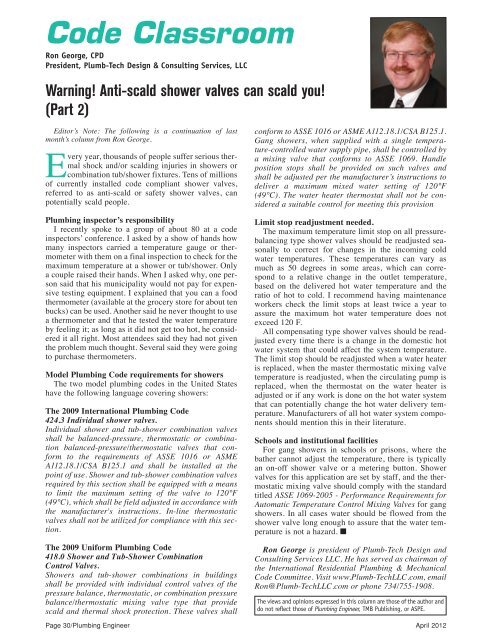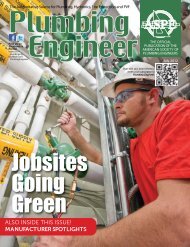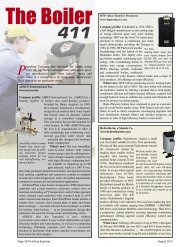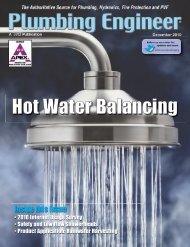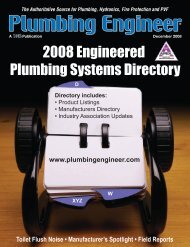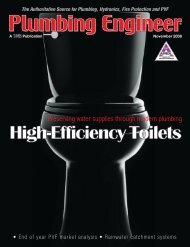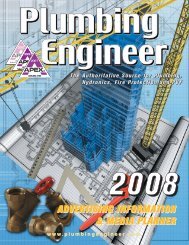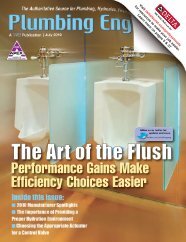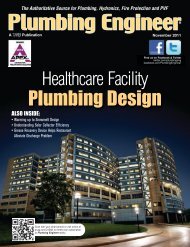open issue - Plumbing Engineer
open issue - Plumbing Engineer
open issue - Plumbing Engineer
Create successful ePaper yourself
Turn your PDF publications into a flip-book with our unique Google optimized e-Paper software.
Code Classroom<br />
Ron George, CPD<br />
President, Plumb-Tech Design & Consulting Services, LLC<br />
Warning! Anti-scald shower valves can scald you!<br />
(Part 2)<br />
Editor’s Note: The following is a continuation of last<br />
month’s column from Ron George.<br />
Every year, thousands of people suffer serious thermal<br />
shock and/or scalding injuries in showers or<br />
combination tub/shower fixtures. Tens of millions<br />
of currently installed code compliant shower valves,<br />
referred to as anti-scald or safety shower valves, can<br />
potentially scald people.<br />
<strong>Plumbing</strong> inspector’s responsibility<br />
I recently spoke to a group of about 80 at a code<br />
inspectors’ conference. I asked by a show of hands how<br />
many inspectors carried a temperature gauge or thermometer<br />
with them on a final inspection to check for the<br />
maximum temperature at a shower or tub/shower. Only<br />
a couple raised their hands. When I asked why, one person<br />
said that his municipality would not pay for expensive<br />
testing equipment. I explained that you can a food<br />
thermometer (available at the grocery store for about ten<br />
bucks) can be used. Another said he never thought to use<br />
a thermometer and that he tested the water temperature<br />
by feeling it; as long as it did not get too hot, he considered<br />
it all right. Most attendees said they had not given<br />
the problem much thought. Several said they were going<br />
to purchase thermometers.<br />
Model <strong>Plumbing</strong> Code requirements for showers<br />
The two model plumbing codes in the United States<br />
have the following language covering showers:<br />
The 2009 International <strong>Plumbing</strong> Code<br />
424.3 Individual shower valves.<br />
Individual shower and tub-shower combination valves<br />
shall be balanced-pressure, thermostatic or combination<br />
balanced-pressure/thermostatic valves that conform<br />
to the requirements of ASSE 1016 or ASME<br />
A112.18.1/CSA B125.1 and shall be installed at the<br />
point of use. Shower and tub-shower combination valves<br />
required by this section shall be equipped with a means<br />
to limit the maximum setting of the valve to 120°F<br />
(49°C), which shall be field adjusted in accordance with<br />
the manufacturer's instructions. In-line thermostatic<br />
valves shall not be utilized for compliance with this section.<br />
The 2009 Uniform <strong>Plumbing</strong> Code<br />
418.0 Shower and Tub-Shower Combination<br />
Control Valves.<br />
Showers and tub-shower combinations in buildings<br />
shall be provided with individual control valves of the<br />
pressure balance, thermostatic, or combination pressure<br />
balance/thermostatic mixing valve type that provide<br />
scald and thermal shock protection. These valves shall<br />
conform to ASSE 1016 or ASME A112.18.1/CSA B125.1.<br />
Gang showers, when supplied with a single temperature-controlled<br />
water supply pipe, shall be controlled by<br />
a mixing valve that conforms to ASSE 1069. Handle<br />
position stops shall be provided on such valves and<br />
shall be adjusted per the manufacturer’s instructions to<br />
deliver a maximum mixed water setting of 120°F<br />
(49°C). The water heater thermostat shall not be considered<br />
a suitable control for meeting this provision<br />
Limit stop readjustment needed.<br />
The maximum temperature limit stop on all pressurebalancing<br />
type shower valves should be readjusted seasonally<br />
to correct for changes in the incoming cold<br />
water temperatures. These temperatures can vary as<br />
much as 50 degrees in some areas, which can correspond<br />
to a relative change in the outlet temperature,<br />
based on the delivered hot water temperature and the<br />
ratio of hot to cold. I recommend having maintenance<br />
workers check the limit stops at least twice a year to<br />
assure the maximum hot water temperature does not<br />
exceed 120 F.<br />
All compensating type shower valves should be readjusted<br />
every time there is a change in the domestic hot<br />
water system that could affect the system temperature.<br />
The limit stop should be readjusted when a water heater<br />
is replaced, when the master thermostatic mixing valve<br />
temperature is readjusted, when the circulating pump is<br />
replaced, when the thermostat on the water heater is<br />
adjusted or if any work is done on the hot water system<br />
that can potentially change the hot water delivery temperature.<br />
Manufacturers of all hot water system components<br />
should mention this in their literature.<br />
Schools and institutional facilities<br />
For gang showers in schools or prisons, where the<br />
bather cannot adjust the temperature, there is typically<br />
an on-off shower valve or a metering button. Shower<br />
valves for this application are set by staff, and the thermostatic<br />
mixing valve should comply with the standard<br />
titled ASSE 1069-2005 - Performance Requirements for<br />
Automatic Temperature Control Mixing Valves for gang<br />
showers. In all cases water should be flowed from the<br />
shower valve long enough to assure that the water temperature<br />
is not a hazard. n<br />
Ron George is president of Plumb-Tech Design and<br />
Consulting Services LLC. He has served as chairman of<br />
the International Residential <strong>Plumbing</strong> & Mechanical<br />
Code Committee. Visit www.Plumb-TechLLC.com, email<br />
Ron@Plumb-TechLLC.com or phone 734/755-1908.<br />
The views and opinions expressed in this column are those of the author and<br />
do not reflect those of <strong>Plumbing</strong> <strong>Engineer</strong>, TMB Publishing, or ASPE.<br />
Page 30/<strong>Plumbing</strong> <strong>Engineer</strong> April 2012


